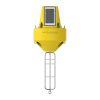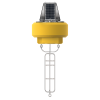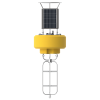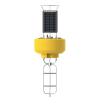NexSens CB-1250 Data Buoy
Features
- Integrated 71-watt solar panels for 213-watts of solar charging
- Three 8" diameter sensor holes with female NPT threads for sensor deployment
- Topside plate supports solar marine light, weather stations, and other sensors
- Expedited repair and warranty service
- Lifetime technical support
- More
The NexSens CB-1250 Data Buoy is designed for deployment in lakes, rivers, coastal waters, harbors, estuaries and other freshwater or marine environments. The floating platform supports both topside and subsurface environmental monitoring sensors including weather stations, wave sensors, thermistor strings, multi-parameter sondes, Doppler current profilers and other monitoring instruments.
The buoy is constructed of an inner core of cross-linked polyethylene foam with a tough polyurea skin. A topside 46” tall stainless steel tower includes three 71-watt 12VDC semi-flexible solar panels, and a center 10” ID x 27.5” tall data well accommodates batteries, data loggers, sensors, and more. Three 8” pass-through holes with female NPT bottom threads allow for quick connection of instrument deployment pipes and custom sensor mounts. The stainless steel frame supports both single point and multi-point moorings.
The CB-1250 Data Buoy is optimized for use with NexSens X3 data loggers. Wireless telemetry options include global 4G LTE cellular, Iridium satellite, and global 4G LTE cellular with Iridium satellite fallback. Compatible digital sensor interfaces include RS-232, RS-485 and SDI-12. Each sensor port offers a UW receptacle connector with double O-ring seal for a reliable waterproof connection. For custom integrations, CB-PTL pass through and CB-MCL wet-mate data well lids are available.
- Hull Outer Diameter: 48.0” (121.9cm)
- Hull Height: 28.0” (71.1cm)
- Data Well Inner Diameter: 10.3” (26.2cm)
- Data Well Height: 27.5" (69.9cm)
- Pass-Through Hole Diameter: 8.0" (20.3cm)
- Tower Height: 46.0” (116.8cm)
- Solar Panels: 3x 71-watts
- Weight: 262 lb (119kg)
- Gross Buoyancy: 1250 lb (567kg)
- Hull Material: Cross-linked polyethylene foam with polyurea coating & stainless steel deck
- Hardware Material: 316 stainless steel
- Mooring Attachments: 3x 3/4” eyenuts
- (1) CB-1250 solar tower
- (1) CB-1250 buoy hull
- (1) CB-CCA anti-rotation cage clamp
- (1) CAGE-L instrument cage
In The News
Stone Lab: Cyanobacteria Monitoring in Ohio Lakes
Microcystin, one of several toxins produced by the cyanobacteria that form harmful algal blooms (HABs), has become a popular topic of lake research as the human health impacts of HABs become better understood. Stone Lab is one of the leading groups in algal bloom research on Lake Erie and other lakes in Ohio. For more than 100 years, Stone Lab has conducted biology research and provided science education and outreach to the region. Over the years, thousands of individuals of varying ages have learned from the resources Stone Lab provides. Stone Lab’s Research Coordinator and Senior Researcher, Justin Chaffin, learned of Stone Lab while an undergraduate student at Bowling Green State University Fireland Campus.
Read MoreExtreme Wave Heights, Ocean Winds Increasing Globally
Around the world, extreme wave heights and ocean winds are increasing. The greatest increase is happening in the Southern Ocean, according to recent research from the University of Melbourne , and Dr. Ian Young corresponded with EM about what inspired the work. “Our main interest is ocean waves, and we are interested in wind because it generates waves,” explains Dr. Young. “Ocean waves are important for the design of coastal and offshore structures, the erosion of beaches and coastal flooding, and the safety of shipping.” Waves also have a role in determining how much heat, energy and gas can be trapped in the ocean. “The major reason why changes in wave height may be important is because of sea level rise,” details Dr. Young.
Read MoreNexSens CB-Series data buoys offers lineup from compact to powerful
The 2014 line of CB-Series data buoys combines traditional NexSens Technology reliability with a number of new innovations designed to handle real-time data collection applications in waters from the Great Lakes to the Arctic. Each of the four CB-Series data buoys comes equipped with at least three solar panels, pass-through holes for water sensor deployment and topside mounts for weather sensors. But the buoys’ most exciting enhancement is the addition of a spacious, cross-compatible instrument well that protects your delicate electronics “The biggest change is we now have a large data well that allows us to integrate batteries, data loggers and other electronics,” said Paul Nieberding, Fondriest Environmental general manager.
Read More













































